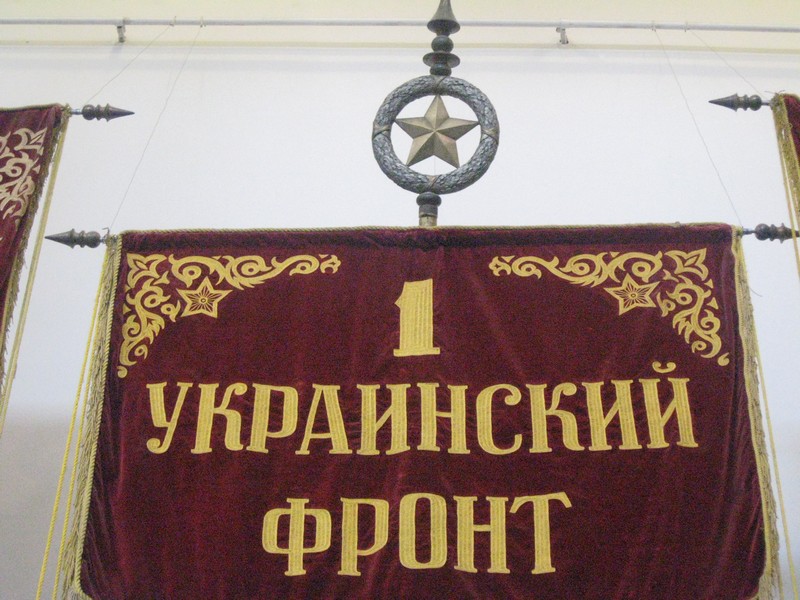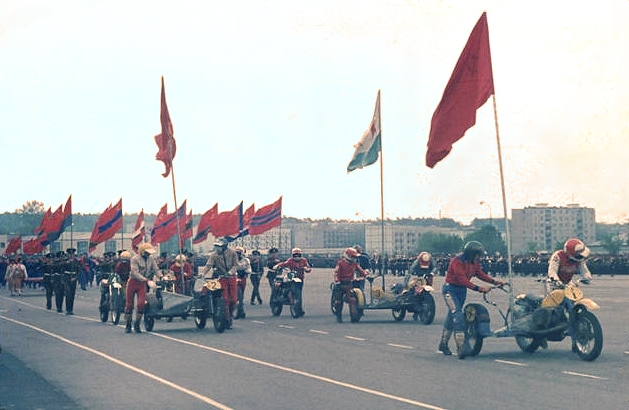|
5th Guards Army (Soviet Union)
The 5th Guards Army was a Soviet Guards formation which fought in many critical actions during World War II under the command of General Aleksey Semenovich Zhadov. The 5th Guards Army was formed in spring 1943 from the 66th Army in recognition of that army's actions during the Battle of Stalingrad. The 5th Guards Army fought in the Battle of Kursk, Belgorod-Khar'kov Offensive Operation, Battle of the Dnieper, Uman–Botoșani Offensive, Lvov–Sandomierz Offensive, Vistula–Oder Offensive, Berlin Offensive, and the Prague Offensive. During the Berlin Offensive elements of the army linked up with American troops at Torgau on the Elbe. Postwar, the army was disbanded as part of the Central Group of Forces. History On 5 May 1943, the 66th Army was renamed to the 5th Guards Army in accordance with a Stavka directive dated 16 April 1943. It included the 32nd and 33rd Guards Rifle Corps. The 5th Guards Army fought under command of the Steppe, Voronezh, and 2nd and 1st Ukrainian ... [...More Info...] [...Related Items...] OR: [Wikipedia] [Google] [Baidu] |
Soviet Union
The Soviet Union,. officially the Union of Soviet Socialist Republics. (USSR),. was a transcontinental country that spanned much of Eurasia from 1922 to 1991. A flagship communist state, it was nominally a federal union of fifteen national republics; in practice, both its government and its economy were highly centralized until its final years. It was a one-party state governed by the Communist Party of the Soviet Union, with the city of Moscow serving as its capital as well as that of its largest and most populous republic: the Russian SFSR. Other major cities included Leningrad (Russian SFSR), Kiev (Ukrainian SSR), Minsk ( Byelorussian SSR), Tashkent (Uzbek SSR), Alma-Ata (Kazakh SSR), and Novosibirsk (Russian SFSR). It was the largest country in the world, covering over and spanning eleven time zones. The country's roots lay in the October Revolution of 1917, when the Bolsheviks, under the leadership of Vladimir Lenin, overthrew the Russian Provisional Government ... [...More Info...] [...Related Items...] OR: [Wikipedia] [Google] [Baidu] |
Battle Of Stalingrad
The Battle of Stalingrad (23 August 19422 February 1943) was a major battle on the Eastern Front of World War II where Nazi Germany and its allies unsuccessfully fought the Soviet Union for control of the city of Stalingrad (later renamed to Volgograd) in Southern Russia. The battle was marked by fierce close-quarters combat and direct assaults on civilians in air raids, with the battle epitomizing urban warfare. The Battle of Stalingrad was the deadliest battle to take place during the Second World War and is one of the bloodiest battles in the history of warfare, with an estimated 2 million total casualties. Today, the Battle of Stalingrad is universally regarded as the turning point in the European Theatre of war, as it forced the '' Oberkommando der Wehrmacht'' (German High Command) to withdraw considerable military forces from other areas in occupied Europe to replace German losses on the Eastern Front, ending with the rout of the six field armies of Army G ... [...More Info...] [...Related Items...] OR: [Wikipedia] [Google] [Baidu] |
Psel River
The Psel (, translit. ''Psyol''; , translit. ''Psel, Ps'ol, Pslo'') is a river, a left tributary of the Dnieper, which flows through Russia and Ukraine. The Psel has a length of and a drainage basin of .Псёл The river's right bank is high and steep, unlike the low, left bank. Its periods of freezing range from December until the end of February to the beginning of April. Tributaries The following rivers are tributaries to the river Psel (from source to mouth): Left: Ilyok,[...More Info...] [...Related Items...] OR: [Wikipedia] [Google] [Baidu] |
Battle Of Prokhorovka
The Battle of Prokhorovka was fought on 12 July 1943 near Prokhorovka, southeast of Kursk, in the Soviet Union, during the Second World War. Taking place on the Eastern Front, the engagement was part of the wider Battle of Kursk and occurred when the 5th Guards Tank Army of the Soviet Red Army attacked the II SS-Panzer Corps of the German Waffen-SS in one of the largest tank battles in history. In April 1943, the German leadership began preparing for Operation Citadel, with the objective of enveloping and destroying the Soviet forces in the Kursk salient by attacking and breaking through the base of the salient from north and south simultaneously. The German offensive was delayed several times because of the vacillation of the leadership (Hitler repeatedly delayed launching the attack so that more Tiger tanks could be delivered to the front, hoping that a technical advantage would help him win the offensive) and the addition of more forces and new equipment. The Soviet hig ... [...More Info...] [...Related Items...] OR: [Wikipedia] [Google] [Baidu] |
1st Ukrainian Front
The 1st Ukrainian Front (Russian: Пéрвый Украи́нский фронт), previously the Voronezh Front (Russian: Воронежский Фронт) was a major formation of the Soviet Army during World War II, being equivalent to a Western army group. Background During the first months of the war, officers from 16 regions of Ukraine conscripted about 2.5 million people from military enlistment offices. 1.3 million militiamen from the left-bank and southern regions of Ukraine fought against the enemy. In 1941, about 3.185 million citizens of the Ukrainian SSR were sent to the Soviet Red Army and Navy. Replenishing mostly the units of the Southern and Southwestern fronts, the Ukrainian people formed the basis of the 37th, 38th, and 40th armies; and the 13th and 17th rifle divisions. Due to the conscription of civilians, the proportion of Ukrainian citizens fighting in south-west Ukraine reached 50%. This significantly exceeded the percentage of Ukrainians from t ... [...More Info...] [...Related Items...] OR: [Wikipedia] [Google] [Baidu] |
2nd Ukrainian Front
The 2nd Ukrainian Front (2-й Украинский фронт), was a front of the Red Army during the Second World War. History On October 20, 1943 the Steppe Front was renamed the 2nd Ukrainian Front. During the Second Jassy–Kishinev Offensive, 2nd Ukrainian Front, led by Army General Rodion Malinovsky, comprised: * 6th Guards Tank Army – Major General A.G. Kravchenko * 4th Guards Army – Ivan Galanin * 7th Guards Army – Lieutenant General M.S. Shumilov * 27th Army – Lieutenant General S.G. Trofimenko * 40th Army – Lieutenant General Filipp Zhmachenko * 52nd Army – Lieutenant General K.A. Koroteev * 53rd Army – Lieutenant General Ivan Managarov * 18th Tank Corps – Major General V.I. Polozkov * Cavalry-Mechanized Group Gorshkov – Major General Sergey Gorshkov **5th Guards Cavalry Corps ** 23rd Tank Corps – Lieutenant General Alexey Akhmanov On 1 January 1945, during the Siege of Budapest, the Front consisted of the * 7th Guards Army, * 27 ... [...More Info...] [...Related Items...] OR: [Wikipedia] [Google] [Baidu] |
Voronezh Front
The 1st Ukrainian Front (Russian: Пéрвый Украи́нский фронт), previously the Voronezh Front (Russian: Воронежский Фронт) was a major formation of the Soviet Army during World War II, being equivalent to a Western army group. Background During the first months of the war, officers from 16 regions of Ukraine conscripted about 2.5 million people from military enlistment offices. 1.3 million militiamen from the left-bank and southern regions of Ukraine fought against the enemy. In 1941, about 3.185 million citizens of the Ukrainian SSR were sent to the Soviet Red Army and Navy. Replenishing mostly the units of the Southern and Southwestern fronts, the Ukrainian people formed the basis of the 37th, 38th, and 40th armies; and the 13th and 17th rifle divisions. Due to the conscription of civilians, the proportion of Ukrainian citizens fighting in south-west Ukraine reached 50%. This significantly exceeded the percentage of Ukrainians from t ... [...More Info...] [...Related Items...] OR: [Wikipedia] [Google] [Baidu] |
Steppe Front
The Steppe Front (russian: Степной фронт) was a front of the Red Army during the Second World War which existed from July to October 1943. History On 9 July 1943, Stavka designated a new Reserve Front in the Voronezh region, that had been effective since 30 April.Great Patriotic War 1941–1945, Moscow 1977 It consisted of the command component of the 2nd Reserve Army (augmented by several officer and NCO courses), the 27th, 52nd, 53rd, 46th, 47th, 4th Guards Tank, 5th Air Army and eight mobile corps (Tank, Guards Tank, and Mechanised). Most of these armies had been reassigned from the Northwestern Front, North Caucasus Front, or the Reserve of the Supreme High Command (''Stavka'' reserve, or the RVGK). On 13 April 1943 the Front was renamed the Steppe Military District, to be effective 15 April. The Steppe Military District was redesignated the Steppe Front on July 9, 1943. It incorporated forces from the Soviet rear areas to the West of Kursk salient along t ... [...More Info...] [...Related Items...] OR: [Wikipedia] [Google] [Baidu] |
32nd Guards Rifle Corps
3 (three) is a number, numeral and digit. It is the natural number following 2 and preceding 4, and is the smallest odd prime number and the only prime preceding a square number. It has religious or cultural significance in many societies. Evolution of the Arabic digit The use of three lines to denote the number 3 occurred in many writing systems, including some (like Roman and Chinese numerals) that are still in use. That was also the original representation of 3 in the Brahmic (Indian) numerical notation, its earliest forms aligned vertically. However, during the Gupta Empire the sign was modified by the addition of a curve on each line. The Nāgarī script rotated the lines clockwise, so they appeared horizontally, and ended each line with a short downward stroke on the right. In cursive script, the three strokes were eventually connected to form a glyph resembling a with an additional stroke at the bottom: ३. The Indian digits spread to the Caliphate in the 9th ... [...More Info...] [...Related Items...] OR: [Wikipedia] [Google] [Baidu] |
Stavka
The ''Stavka'' (Russian and Ukrainian: Ставка) is a name of the high command of the armed forces formerly in the Russian Empire, Soviet Union and currently in Ukraine. In Imperial Russia ''Stavka'' referred to the administrative staff, and to the General Headquarters in the late 19th-century Imperial Russian armed forces and subsequently in the Soviet Union. In Western literature it is sometimes written in uppercase (''STAVKA''), although whether it is an acronym is a subject of debate. ''Stavka'' may refer to its members, as well as to the headquarters location (its original meaning from the old Russian word ''ставка'', 'tent'). Stavka of the Supreme Commander during World War I The commander-in-chief of the Russian army at the beginning of World War I was Grand Duke Nicholas Nicholaievitch, a grandson of Tsar Nicholas I. Appointed at the last minute in August 1914, he played no part in formulating the military plans in use at the beginning of the war. Nik ... [...More Info...] [...Related Items...] OR: [Wikipedia] [Google] [Baidu] |
Central Group Of Forces
The Central Group of Forces (Russian: Центральная группа войск) was a formation of the Soviet Armed Forces used to incorporate Soviet troops in Central Europe on two occasions: in Austria and Hungary from 1945 to 1955 and troops stationed in Czechoslovakia after the Prague Spring of 1968. History First formation After the end of the Second World War, the Soviet High Command (Stavka) reorganized its troops on the territories it liberated from the Nazi occupation and now occupied. Stavka Directive Nr 11097 on 10 June 1945 created several new formations, known as ''Groups of Forces'', equivalent to military districts but located outside the Soviet Union. The Central Group of Forces was created around that time from the 1st Ukrainian Front to control troops in Austria and Hungary, and did so from 1945 until 1955, when Soviet troops were withdrawn from Austria after the Austrian State Treaty was agreed. Its first commander was Marshal of the Soviet Union Iva ... [...More Info...] [...Related Items...] OR: [Wikipedia] [Google] [Baidu] |
.jpg)




